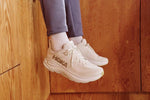
What Makes A Running Shoe - The Midsole
, by Chiappetta Shoes , 15 min reading time

, by Chiappetta Shoes , 15 min reading time
At Chiappetta Shoes, we know the best runs happen when every part of your shoe works in harmony. In this first installment of our What Makes a Running Shoe series, we’re starting with the midsole: the core layer that defines how your shoes cushion, support, and performance.
From shock absorption and energy return to stability and responsiveness, the midsole is what truly sets one running shoe apart from another. Let’s dig into why this central layer matters so much for every step you take.
The midsole has come a long way since the mid 1900s. Early athletic shoes offered little more than leather uppers and rubber soles, with almost no cushioning. The introduction of EVA foam in the 1970s changed everything, creating lightweight, shock-absorbing midsoles that became the standard. By the 1980s and ’90s, brands were layering in air, gel, and stability features to improve comfort and control. Today, midsoles are built with advanced “super foams” and even carbon plates, turning this once-simple layer into the performance engine of modern running shoes.
A midsole isn’t just a block of foam, it’s carefully engineered to influence how your foot moves through every stride. Key design features include:
Stack Height – The total thickness of the midsole. Higher stacks mean more cushion, while lower stacks keep you closer to the ground for a more natural feel.
Heel-to-Toe Drop – The difference in height between the heel and forefoot. A higher drop encourages forward momentum and eases strain on calves, while a lower drop promotes a more natural gait.
Geometry & Rocker Design – Many midsoles are sculpted with curves or rockers to reduce impact and make transitions smoother. These design details can dramatically change how a shoe feels, even with the same materials.
These construction choices are why two shoes with EVA foam can perform completely differently on your feet.
Ever had running shoes that felt amazing in the store but left you sore after a few miles? That often comes down to this cushioning platform’s design and materials.
A well-engineered core layer offers:
Impact absorption to reduce stress on knees, hips, and feet
Support for mechanics like pronation or supination
Energy return for a more effortless stride
Stability to keep your gait balanced and controlled
These layers range from plush foams to firm, responsive materials. Choosing the right one depends on your unique foot shape and running style.
Midsoles come in different materials and densities, each serving different runner needs:
Soft foam midsoles offer plush cushioning and shock absorption, ideal for neutral runners or those who prefer a softer ride.
Firm midsoles provide greater stability and responsiveness, helping runners who overpronate or have rigid foot types like the C9 foot type.
Dual-density midsoles combine cushioning and control, helping guide your foot through a balanced stride.
At Chiappetta Shoes, we help you select shoes with midsoles suited to your gait, then fine-tune your support with custom orthotics when needed.
Persistent pain in knees, hips, or feet
Feeling unstable or rolling your ankles
Flattened or compressed cushioning
Increased fatigue during runs
If you notice any of these, it may be time to replace your shoes or assess whether orthotics can enhance your support, ensuring you maintain comfort and reduce injury risk.
Every runner’s stride is unique, which is why there’s no one-size-fits-all shoe. At Chiappetta Shoes, we combine gait analysis and expert fittings to match you with shoes that align with your mechanics. From there, we fine-tune your support with custom orthotics, ensuring the shoe works with your foot, not against it.
This blend of shoe technology and personalized fitting is what keeps our customers running comfortably, mile after mile.
The midsole is the layer between the outsole and upper that provides cushioning, support, and stability.
Common materials include EVA (soft, lightweight foam), PU (dense and durable), and TPU (responsive with high energy return).
A: Look for compressed cushioning, pain in knees/hips/feet, instability, or increased fatigue during runs.
Soft midsoles are ideal for neutral runners, firm midsoles for overpronators, and dual-density midsoles combine cushioning and control.
The insole (also called the sockliner) is the top layer inside the shoe that your foot directly rests on. It provides comfort, minor cushioning, and sometimes odor control or moisture-wicking properties.
The midsole sits beneath the insole and above the outsole. It’s the main cushioning and support layer of the shoe, designed to absorb impact, stabilize your foot, and improve energy return while running or walking.
In short: The insole is for direct comfort under your foot, while the midsole is the structural layer that affects performance, support, and overall ride.


